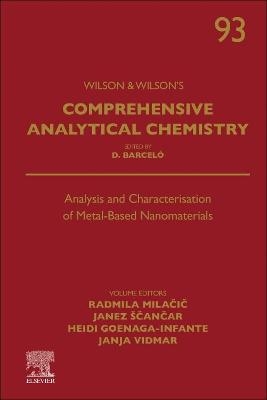
Analysis and Characterisation of Metal-Based Nanomaterials
Elsevier - Health Sciences Division (Verlag)
978-0-323-85305-7 (ISBN)
She has been active in scientific research for more than 40 years. She is a Head of Laboratory for Environmental Analytical Chemistry and Deputy of a Head of Department of Environmental Sciences at the Jožef Stefan Institute, Ljubljana, Slovenia. Her research is mainly devoted to the investigation of the role of metal ions and metal-based nanoparticles in the environment and living organisms using the methods of chemical speciation and sizing of nanoparticles. By the use of use of stable isotopic tracers, she is engaged in studies of species transformation during the analytical procedures and in the environment and living organisms. As full professor, she is lecturing at Jožef Stefan International Postgraduate School. She has published more than 170 original scientific articles, is a co-editor of one book and contributed 10 book chapters. He has been actively involved in the research for almost 30 years. Since 1997 he is employed at the Jožef Stefan Institute, Ljubljana, Slovenia. Currently, he is a Head of Research Group for Trace Elements Speciation. His main research interests are investigations on the role of metal ions in the environment and living organisms by applying methods of chemical speciation and the use of stable isotopes. Part of these investigations are metal-based nanoparticles. As a full professor he is engaged in lecturing at the Jožef Stefan International Postgraduate School and at the University of Nova Gorica. Among others, he has written more than 150 original scientific articles papers in analytical, environmental and life science journals. She is employed as a Research Fellow at the Department of Environmental Sciences at the Jožef Stefan Institute, Ljubljana, Slovenia, where she obtained her PhD in 2017. Her research work lies in the field of inorganic analytical chemistry of the environmental and biological systems. She has been focused on detection and characterization of metal-based nanoparticles in environmental, biological and food samples, mainly with the use of single-particle inductively coupled plasma mass spectrometry. She has worked on several European and national research projects and published more than 30 scientific papers. Her scientific career of over twenty years of experience on elemental and speciation analysis started with the award of a PhD from Oviedo University, Spain. She joined LGC in 2003. She is the Principal Scientist and Team Leader of the Inorganic Analysis team at the National Measurement Laboratory hosted at LGC. Her team includes fifteenth PhDs and postgraduate scientists with expertise across trace element speciation analysis, metallomics research, the characterisation of nanomaterials, high accuracy isotope ratio analysis, quantitative elemental bio-imaging and the characterisation of “speciated reference materials and standards. Heidi is the UK representative at the Inorganic Analysis Working Group of the CCQM, the international Consultative Committee for Metrology in Chemistry. She is the chair of the editorial board of the Journal of Analytical Atomic Spectrometry and, a member of the international advisory boards of Analytical and Bioanalytical Chemistry and the RSC journal Metallomics. She is the LGC representative at ISO TC 24 (Particle characterisation). She is the EURAMET representative for inorganic analysis at the CCQM Key Comparison Working Group. She has acted as the coordinator of the EU EUROPEAN Metrology Research Proposal (EMRP) NanoChop “Chemical, Optical and Biological characterisation of nanomaterials in biological samples and as work package leader in other several EU projects. She is the leading author of over a 120 scientific research papers and 6 book chapters. She is a Science Fellow of LGC. Heidi was recently awarded the 2020 Lester W. Strock Award from SAS.
1. Occurrence, behaviour and effects of inorganic nanoparticles in the environment Geert Cornelis and Elma Lahive 2. Single-Particle Inductively Coupled Plasma Mass Spectrometry for the analysis of inorganic engineered nanoparticles: Metrological and quality issues Francisco Laborda, Ana C. Gimenez-Ingalaturre and Eduardo Bolea 3. Multiplexed and multi-metal Single-Particle characterization with ICP-TOFMS Alexander Gundlach-Graham 4. Characterisation of inorganic nanomaterials in complex samples by hyphenated Field Flow Fractionation Heidi Goenaga-Infante, Dorota Bartczak and Isabel Abad Alvaro 5. Hydrodynamic chromatography for the characterization of inorganic nanoparticles Marco Roman 6. Imaging of metal-based nanoparticles in tissue and cell samples by ICP-based techniques Heike Traub 7. Microscopic techniques for the characterization of metal-based nanoparticles Janez Zavasnik, Vasyl Shvalya and Andreja Sestan 8. The use of High Performance Liquid Chromatography - Inductively Coupled Plasma Mass Spectrometry in the analysis of inorganic nanomaterials Maria Montes-Bayon and Jorg Bettmer 9. Characterization of metal-based nanoparticles as contrast agents for magnetic resonance imaging Nina Kostevsek and Igor Sersa 10. Detection and characterization of metal-based nanoparticles in environmental, biological and food samples by single particle Single Particle Inductively Coupled Plasma Mass Spectrometry Janja Vidmar 11. Metal and metal oxide nanoparticles in cosmetics and skin care products Fabienne Seby
| Erscheinungsdatum | 02.06.2021 |
|---|---|
| Reihe/Serie | Comprehensive Analytical Chemistry |
| Verlagsort | Philadelphia |
| Sprache | englisch |
| Maße | 152 x 229 mm |
| Gewicht | 830 g |
| Themenwelt | Naturwissenschaften ► Chemie ► Analytische Chemie |
| ISBN-10 | 0-323-85305-6 / 0323853056 |
| ISBN-13 | 978-0-323-85305-7 / 9780323853057 |
| Zustand | Neuware |
| Informationen gemäß Produktsicherheitsverordnung (GPSR) | |
| Haben Sie eine Frage zum Produkt? |
aus dem Bereich


